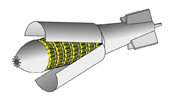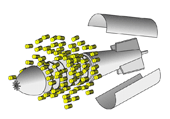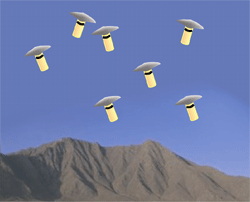The drop
 A cluster munition (in this example, one containing 202 'BLU 97 A/B' submunitions) is dropped from a plane. The bomb can fly about nine miles before the submunitions are released.
A cluster munition (in this example, one containing 202 'BLU 97 A/B' submunitions) is dropped from a plane. The bomb can fly about nine miles before the submunitions are released.
Spinning and opening
A short time before the submunitions are released, the container begins to spin, and opens at an altitude of between 330 ft and 3,300 ft. The height, velocity and rotation speed determine how large an area will be impacted by the submunitions when they strike.
Parachutes open, nose down
 Each submunition is about the size of a soda can. They each deploy a little parachute that stabilizes them and makes sure that they descend with their nose down. Each submunition is made of a copper cone that can pierce through seven inches of armor, and contains more than 300 pieces of preformed steel fragmentation pieces designed to destroy human targets, as well as incendiary material (zirconium) to cause burning.
Each submunition is about the size of a soda can. They each deploy a little parachute that stabilizes them and makes sure that they descend with their nose down. Each submunition is made of a copper cone that can pierce through seven inches of armor, and contains more than 300 pieces of preformed steel fragmentation pieces designed to destroy human targets, as well as incendiary material (zirconium) to cause burning.
Impact, injury... and a few duds, too
Depending on the wind conditions and the altitude at which the submunitions are released, each bomb container can cover an area of up to 861,120 square feet with submunition strikes.
When the submunitions explode, they cause injury and damage across a wide area. The blast of one submunition can cause deadly shrapnel injuries in a 65-foot radius and injure anyone within a 328-foot radius.
Moreover, many of the submunitions fail to detonate upon impact, leaving behind large numbers of hazardous explosive “duds.” These duds are akin to landmines, injuring and killing civilians and contaminating the land long after conflicts end. The percentage of unexploded submunitions from each canister varies but can be as high as 30%.



 A cluster munition (in this example, one containing 202 'BLU 97 A/B' submunitions) is dropped from a plane. The bomb can fly about nine miles before the submunitions are released.
A cluster munition (in this example, one containing 202 'BLU 97 A/B' submunitions) is dropped from a plane. The bomb can fly about nine miles before the submunitions are released.
 Each submunition is about the size of a soda can. They each deploy a little parachute that stabilizes them and makes sure that they descend with their nose down. Each submunition is made of a copper cone that can pierce through seven inches of armor, and contains more than 300 pieces of preformed steel fragmentation pieces designed to destroy human targets, as well as incendiary material (zirconium) to cause burning.
Each submunition is about the size of a soda can. They each deploy a little parachute that stabilizes them and makes sure that they descend with their nose down. Each submunition is made of a copper cone that can pierce through seven inches of armor, and contains more than 300 pieces of preformed steel fragmentation pieces designed to destroy human targets, as well as incendiary material (zirconium) to cause burning.

